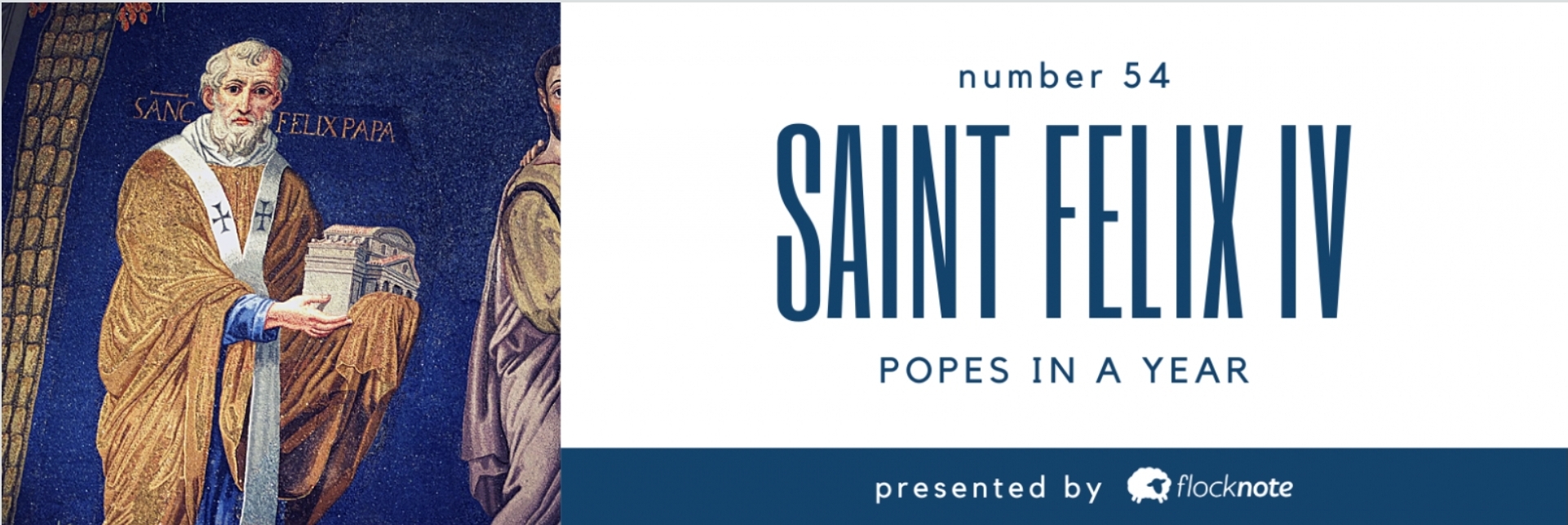
Died: 530 A.D.
Again, what’s the deal with the name?
If you’ll remember, an antipope styled himself “Felix II” during the reign of Pope Liberius in the mid 4th Century. Since his name was mistakenly on the papal books for a while afterward, when the real second Pope Felix came around, it was easier to refer to him as “Felix III” to avoid confusion. So, although today’s Pope Felix is really only the third pope to bear the title, he’s instead known as “Felix IV.”
Give me the scoop on Felix IV.
The situation was testy in Rome following the imprisonment and death of Pope St. John I, especially when Theodoric, the king of Italy, strongly suggested that Felix be his successor. Though the nomination was non-typical in nature (to say the least), the clergy and laity followed the king’s lead and voted Felix into office on July 12, 526. Thankfully, Felix was a stand-up guy and (more importantly) not a heretic.
Throughout his 4-year reign, Felix dealt with what’s become known as the “Semi-Pelagian” conflict, which dealt with proper teaching on grace and free will, and published his corrections of the heresy as canons at the Council of Orange in 529. He died in September of the year 530, but his feast day is celebrated on January 30.
What was he known for?
Sensing that history might repeat itself after his death, Felix attempted to appoint his own successor instead of leaving it to those who favored the shaky heretical beliefs still boiling in the East, or to those who supported Gothic rule in Italy. So when he fell ill in 530, Felix pointed to a certain Boniface as his successor, making his wishes well known in that regard. Unfortunately, however, history did repeat itself; only a minority of Roman clergy sided with Boniface while a majority nominated a different man. We’ll learn how Boniface ended up becoming pope – despite the opposition – tomorrow.
Fun Fact…
A likeness of St. Felix IV (seen above) can be found in Rome, in the Church of Ss. Cosmas and Damian. After Theodoric’s death, the late king’s daughter, Amalasuntha, took the throne until her son reached maturity. While in power, the queen gifted two Roman temples to the Church, which Felix decided to convert into the church that still stands today. He is depicted in a mosaic (seen above) alongside the two saints above the church’s high altar.
What else was going on in the world at the time?
The Benedictine Order was founded in Naples a year before Felix’s death, in 529. Though it’s unclear whether St. Benedict intended to found an order, it was that year in which he built the order’s first monastery at Subiaco, Italy. Before his death, Benedict built 11 more abbeys, and his storied order is just 11 years from their 1500th anniversary.
Coming tomorrow….Pope Boniface II
Can’t get enough papal history?
Click here to listen to The Popecast, a short podcast about popes from the author of Popes in a Year.
SOURCES (and further reading)
John, E. (1964). The Popes: A concise biographical history. New York: Hawthorn Books.
Pope St. Felix IV – http://www.newadvent.org/cathen/06031a.htm
Pope Felix IV – https://en.wikipedia.org/wiki/Pope_Felix_IV
The Benedictines – http://www.osb.org/gen/benedictines.html
Sent by Matthew Sewell